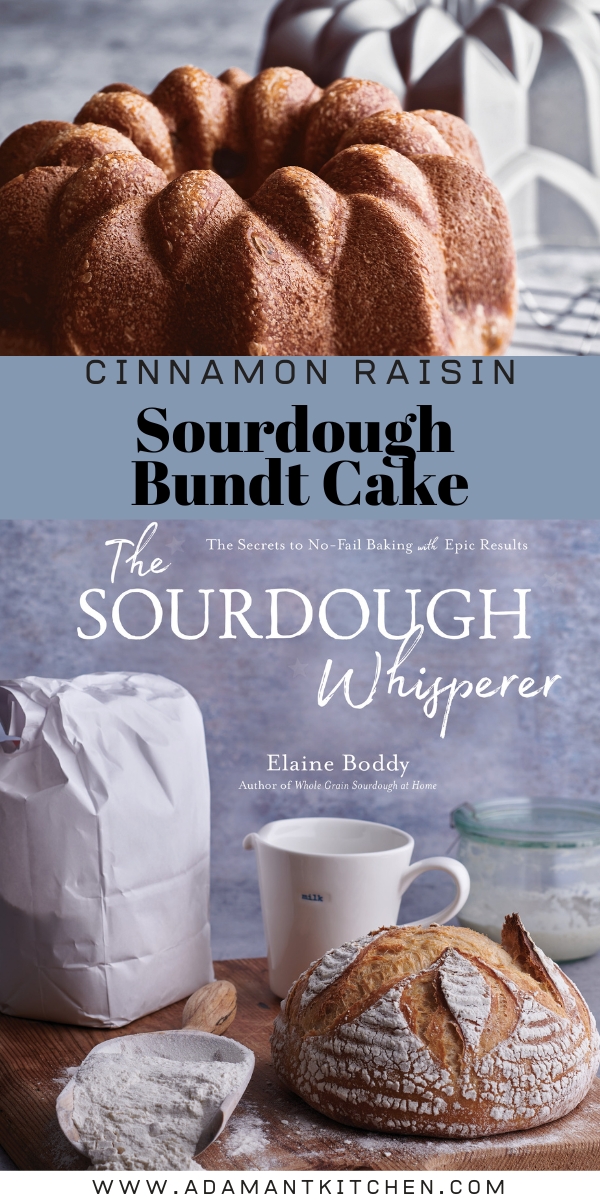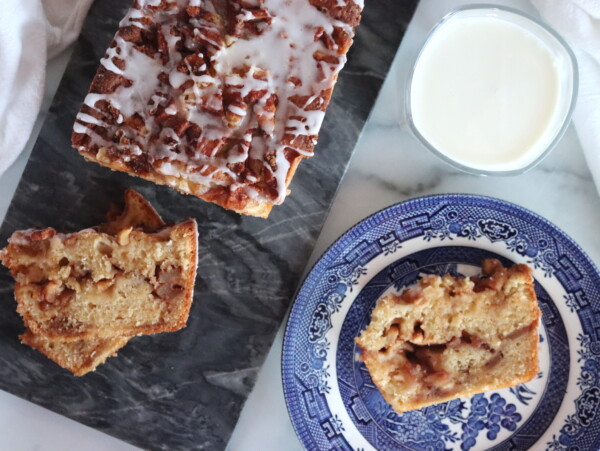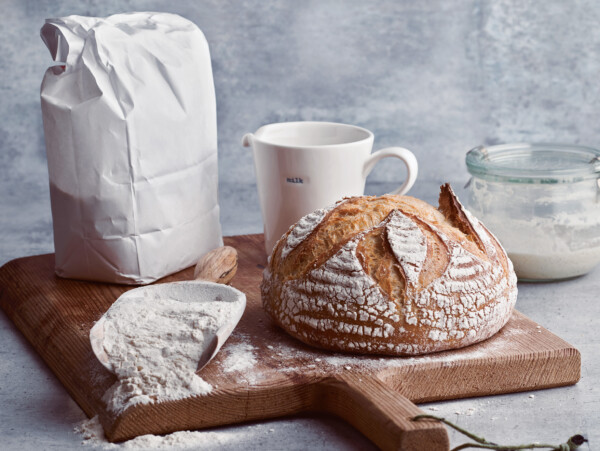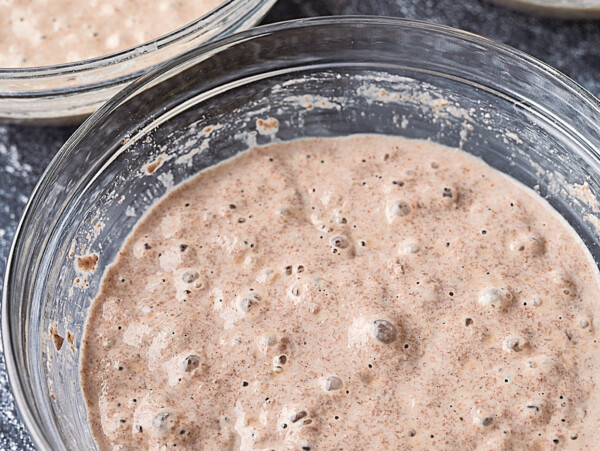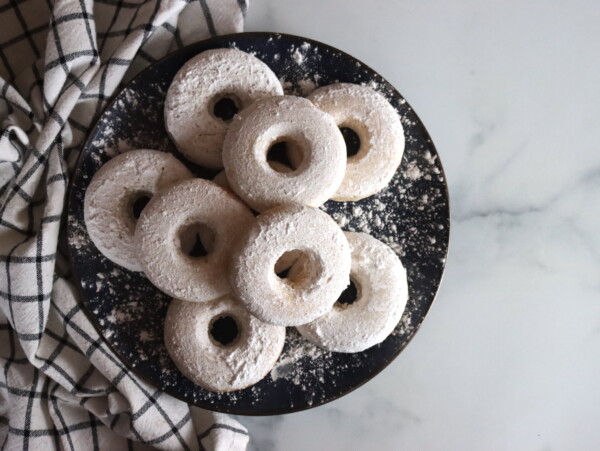This post may contain affiliate links. Please see our disclosure policy.
Sourdough Bundt Cake with cinnamon and raisins is the perfect balance of tangy sourdough flavor, warm cinnamon, and sweet raisins. Whether enjoyed on its own or with a pat of butter, it’s an irresistible treat for any occasion, especially when served fresh from the oven!
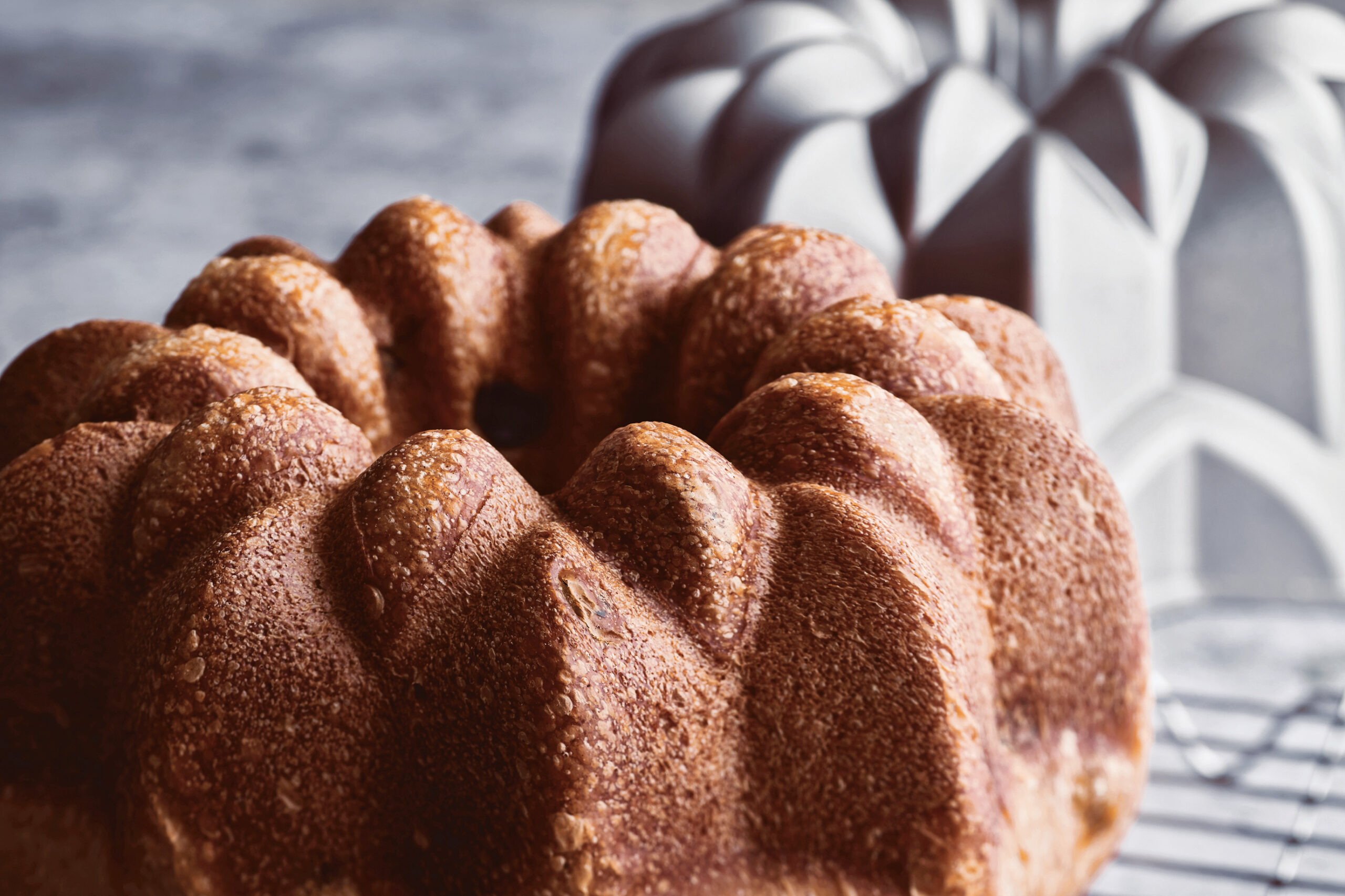
If you love sourdough and are looking for a creative way to use your starter, this Cinnamon Raisin Sourdough Bundt Cake is the perfect recipe to try. The soft, pillowy texture of the dough combines with the sweet cinnamon-spiced flavor and the occasional pop of raisins for a truly indulgent treat. It’s perfect for breakfast, dessert, or even as a snack with a dollop of butter. Plus, the Bundt pan gives it an attractive, eye-catching shape that’s sure to impress!
This particular tested recipe comes from the book The Sourdough Whisperer by Elaine Boddy. She was also kind enough to share her recipe for Soft Sourdough Bread, which is amazing, by the way. If you love sourdough but are craving something a bit softer, be sure to check that recipe out as well. It’s so good, it’s what she used as the cover picture on her book!
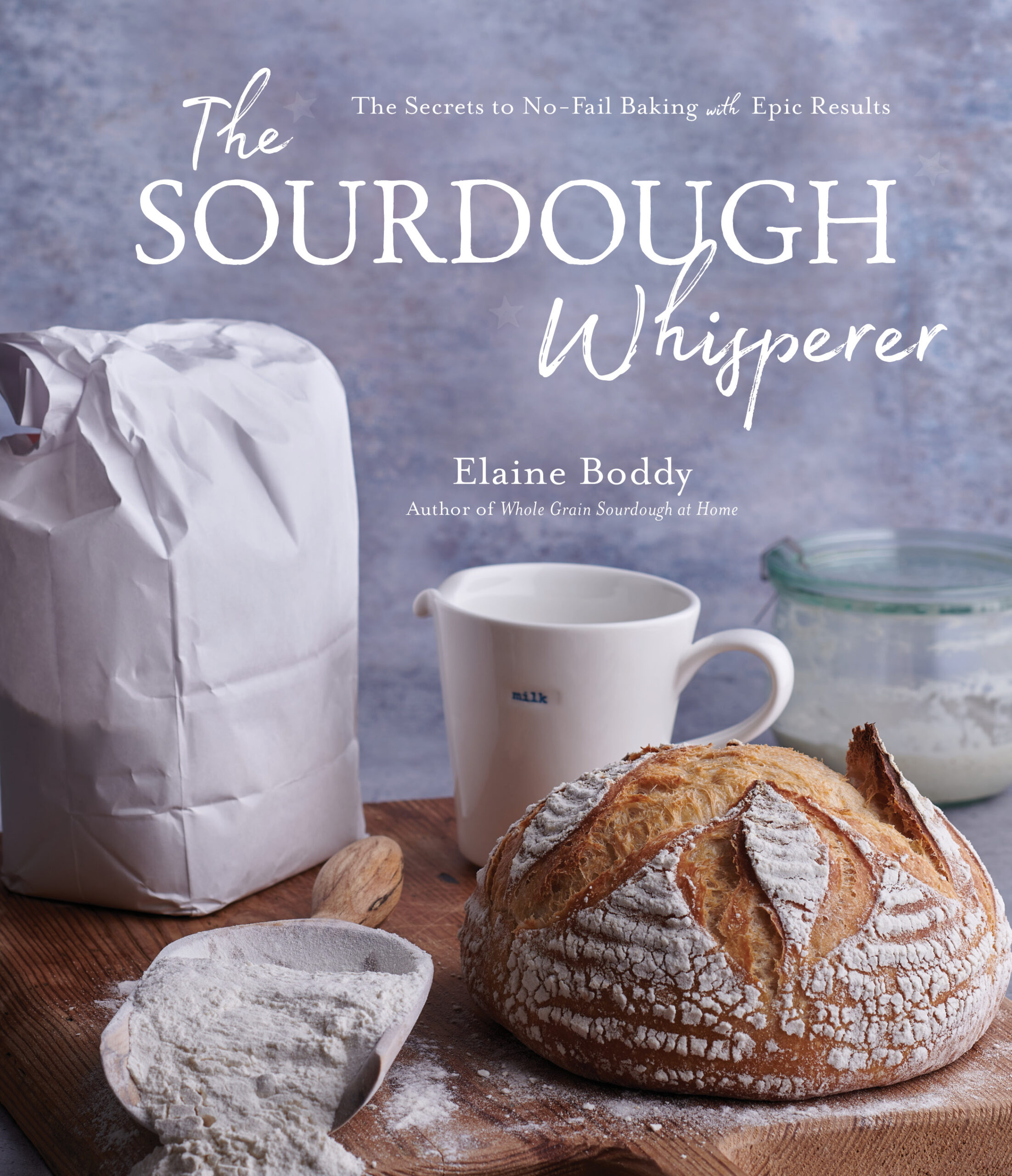
Reprinted with permission from The Sourdough Whisperer by Elaine Boddy. Page Street Publishing Co. 2022.
Sourdough Cinnamon Raisin Cake
I love using Bundt pans for my sourdough recipes; you can create such unusually shaped breads, whether sweet or savory, and create attractive showpieces for your dinner table. This creation includes cinnamon and raisins. Eat it on its own or slathered with butter!
Feed your starter to generate the 100 grams (1⁄2 cup) of active starter needed for the recipe. You will need a 12-cup (2.8-L) Bundt pan, and most bundt pans of that size are 10 1⁄2 inches (26.7 cm) in diameter and 4 1⁄2 inches (11.5 cm) deep.
Ingredients for Sourdough Bundt Cake
To make 1 sourdough bundt cake, you’ll need:
- Active Sourdough Starter: You’ll need 100 grams (1/2 cup) of active sourdough starter. Be sure it’s bubbly and fully active, as this will give your cake the perfect rise and a tangy flavor.
- Milk: 245 grams (1 cup) of milk (cold or at room temperature). You can use full-fat milk, reduced-fat, or even dairy-free milk as a substitute, though the milk contributes to the cake’s soft texture.
- Egg & Egg Yolk: One whole egg and one additional egg yolk help give the cake structure and moisture. The egg yolk adds richness, while the egg white provides lift.
- Butter: 75 grams (3/8 cup) of butter (slightly salted), softened to room temperature. Butter adds flavor and helps create a tender crumb, but you can substitute it with neutral oils like vegetable oil if you prefer.
- Honey: 50 grams (1/4 cup) of runny honey. Honey adds a lovely, subtle sweetness and moisture to the cake. You can also use maple syrup or agave nectar if you prefer.
- Strong White Bread Flour: 500 grams (4 cups) of strong white bread flour. Bread flour has a higher protein content, which helps provide structure to the cake. You can use all-purpose flour, but the result may not have the same chewy texture.
- Ground Cinnamon: 8 grams (1 tablespoon) of ground cinnamon. Cinnamon is the key spice in this cake, giving it a warm, comforting flavor that pairs beautifully with the sourdough’s tang.
- Raisins: 100 grams (1/2 cup) of raisins. Raisins add sweetness and texture, and they pair wonderfully with the cinnamon. Feel free to substitute them with other dried fruits like currants, sultanas, or even chopped dried apricots.
- Salt: 7 grams (1 teaspoon) of salt. Salt is essential for balancing the flavors and enhancing the sweetness of the raisins and honey.
- Rice Flour: You’ll need some rice flour for dusting your Bundt pan. It prevents sticking and helps the cake come out of the pan smoothly once baked. You can substitute with regular flour if necessary, but rice flour will create a smoother, non-greasy finish.
How to Make Cinnamon Raisin Sourdough Bundt Cake
Start by feeding your sourdough starter and allowing it to activate (this should take a few hours), ensuring you have 100 grams of starter ready for use. In the evening, combine the starter, milk, egg, egg yolk, butter, honey, bread flour, cinnamon, raisins, and salt in a large mixing bowl. Mix everything together roughly—don’t worry about the butter being fully incorporated at this stage, as it will come together in the next steps. The dough will be sticky, so using a spatula or bowl scraper can help. Cover the bowl with a clean shower cap or another cover and let it rest on the counter for the night.
After about an hour, perform your first round of pulls and folds. This involves lifting and stretching the dough across the bowl until it starts forming a soft ball. The dough will still be sticky, and the butter might not be fully mixed in, but continue working with it as best as you can. Let the dough rest again, covered. Over the next few hours, perform three additional sets of pulls and folds, each time covering the dough afterward and letting it sit. The dough will become more stretchy and will start to come together into a nice soft ball. Complete your last set of folds before going to bed.
Let the dough rest overnight, typically between 8 to 12 hours, at a temperature of 64–68°F (18–20°C). In the morning, the dough should have doubled or tripled in size. If it hasn’t quite reached that point, just give it a little more time. This dough is heavy, so it may take a bit longer to fully proof.
Once the dough has proofed, lightly dust your Bundt pan with rice flour. Turn the dough onto a lightly floured surface, and shape it into a round ball. Use your fingers to gently create a hole in the center, forming a large “bagel” shape. Place the dough into the Bundt pan with the smooth side down, ensuring the hole aligns with the pan’s center. Cover the pan with your lid or cover, and let it proof for an additional 2 to 4 hours, until it’s risen to 1 to 1 1/2 inches below the edge of the pan.
When the dough is ready, you have two options for baking. If you’d like to preheat your oven, set it to 325°F (160°C) convection or 350°F (180°C) conventional, and bake for 50 to 55 minutes, covered. If you’re using a cold start, place the Bundt pan directly into the oven (cold) and set the timer for 55 to 60 minutes. The cake is ready when it’s golden brown and sounds hollow when tapped.
Once baked, remove the Bundt pan from the oven and allow the cake to cool for about 5 minutes. Carefully turn it out onto a wire rack to cool completely. This cake is perfect on its own, but you can also enjoy it slathered with butter for an extra treat!
Tips for Success
- If you don’t have a Bundt pan, you can use a standard round or loaf pan, but the signature Bundt shape is truly part of the charm of this cake.
- Ensure your starter is active and bubbly before using it to get the best rise and flavor.
- For extra flavor, you can add chopped nuts or a sprinkle of sugar on top before baking.
Enjoy your homemade Cinnamon Raisin Sourdough Bundt Cake as a delightful treat for any occasion, or simply as a beautiful, tangy twist on a classic cake!
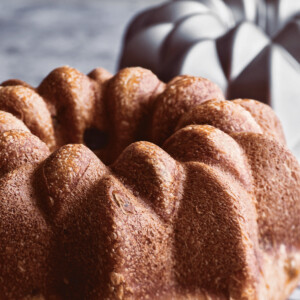
Sourdough Cinnamon Raisin Bundt Cake
Equipment
Ingredients
- 1/2 cup sourdough starter, bubbly active
- 1 cup milk, cold or at room temperature, dairy or plant-based, such as oat or almond
- 1 large egg
- 1 large egg yolk
- 3/8 cup butter, at room temperature
- 1/4 cup honey, runny
- 4 cups white bread flour
- 1 tbsp cinnamon, ground
- 1/2 cup raisins
- 1 tsp salt, or to taste
- Rice flour or regular flour, for dusting
Instructions
- Mix the Dough: In a large mixing bowl, combine all the ingredients, except the reserved egg white and rice flour. Stir the mixture together, using a bowl scraper or spatula to help with the sticky dough. Don’t worry if the butter isn’t fully incorporated yet—it will come together as you work the dough in the next steps. Cover with a clean shower cap or cloth and leave it on the counter for 1 hour.
- First Pull and Fold: After an hour, perform the first set of pulls and folds on the dough. Lift and pull the dough across the bowl until it starts to come together into a soft ball. The dough will remain sticky, but continue working it. Cover the bowl again and let it rest for the next few hours.
- Repeat Pulls and Folds: Over the next few hours, perform three more sets of pulls and folds, covering the bowl after each set. Each time, the dough will become stretchier and smoother, and the butter will blend in more fully. After the final fold, cover the bowl and leave it on the counter overnight, for 8 to 12 hours (at 64 to 68°F / 18 to 20°C).
- Proof the Dough: The dough should double in size overnight. If it hasn’t, allow it a few more hours to continue to rise. Prepare your Bundt pan by lightly dusting it with rice flour.
- Shape and Place in Bundt Pan: Once the dough has doubled, perform a final set of pulls and folds to shape the dough into a ball. Sprinkle rice flour on your hands and the dough, then gently ease a hole into the center (like a large bagel). Place the dough into the prepared Bundt pan, ensuring the hole aligns with the center post. Cover the pan with a cloth or plastic wrap and allow the dough to proof for 2 to 4 hours, until it rises about 1 to 1 1/2 inches (2.5 to 4 cm) below the top of the pan.
- Bake the Cake: Decide whether you want to bake with a preheated oven or start cold:
- Preheated Oven: Set the oven to 325°F (160°C) for convection or 350°F (180°C) for conventional. Place parchment paper over the top of the Bundt pan, followed by a baking sheet, to cover the dough. Bake for 50 to 55 minutes.
- Cold Start: If starting with a cold oven, place the covered Bundt pan into the oven and set the temperature as directed. Bake for 55 to 60 minutes, or until the loaf is nicely browned.
- Cool the Cake: After baking, remove the loaf from the oven and let it cool for 5 minutes. Then, turn it out onto a wire rack to cool completely.
Notes
Nutrition
Nutrition information is automatically calculated, so should only be used as an approximation.
